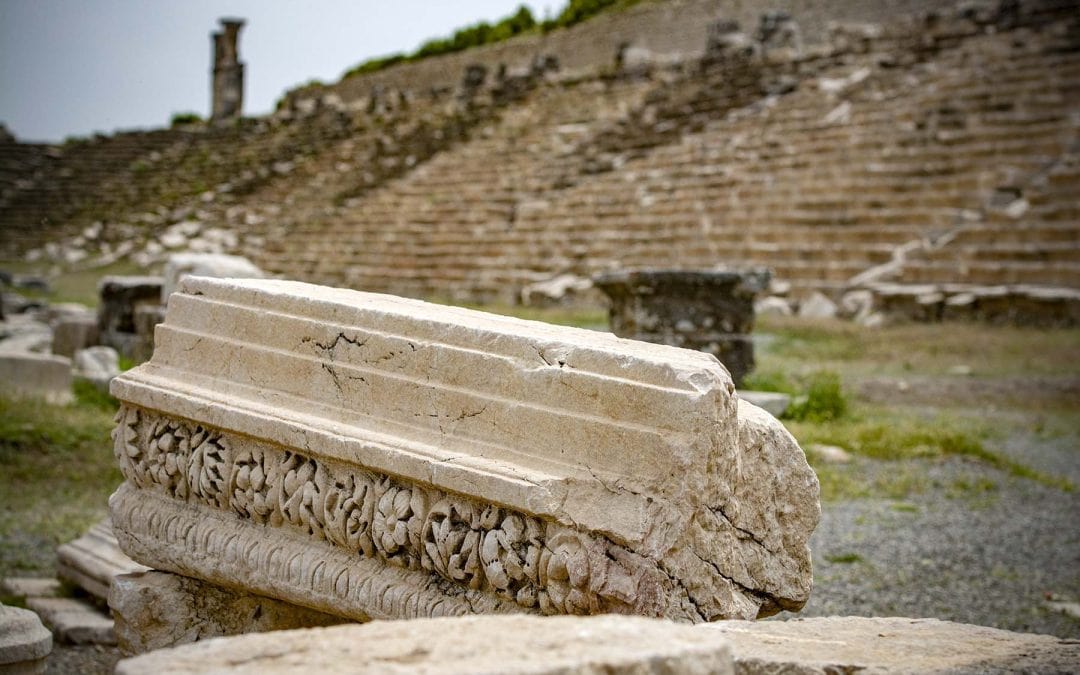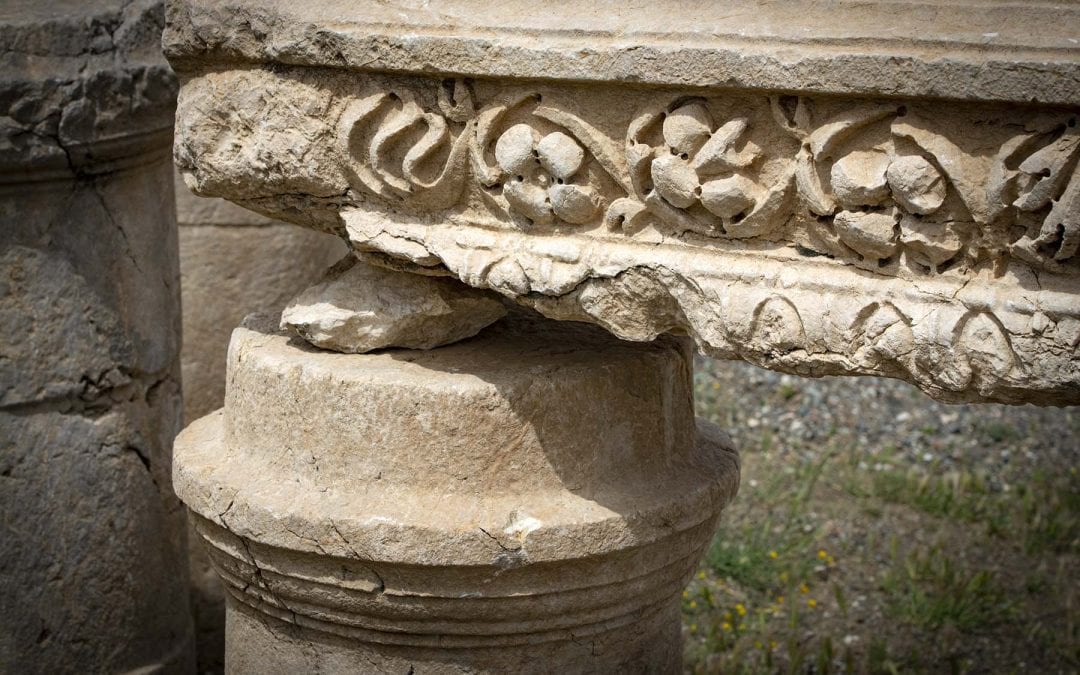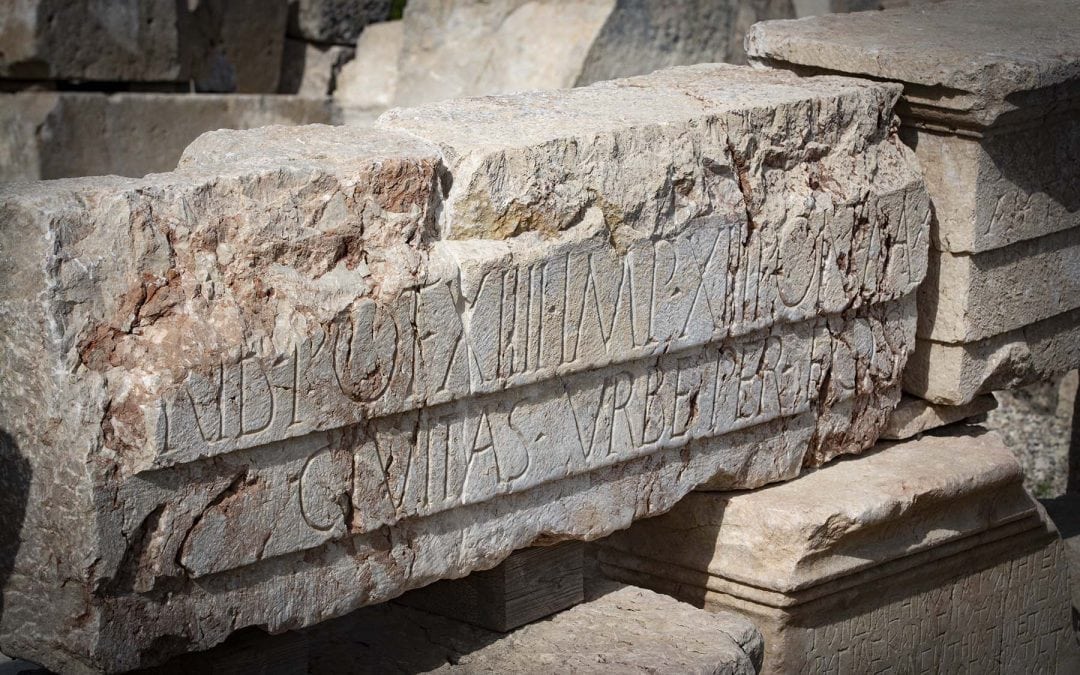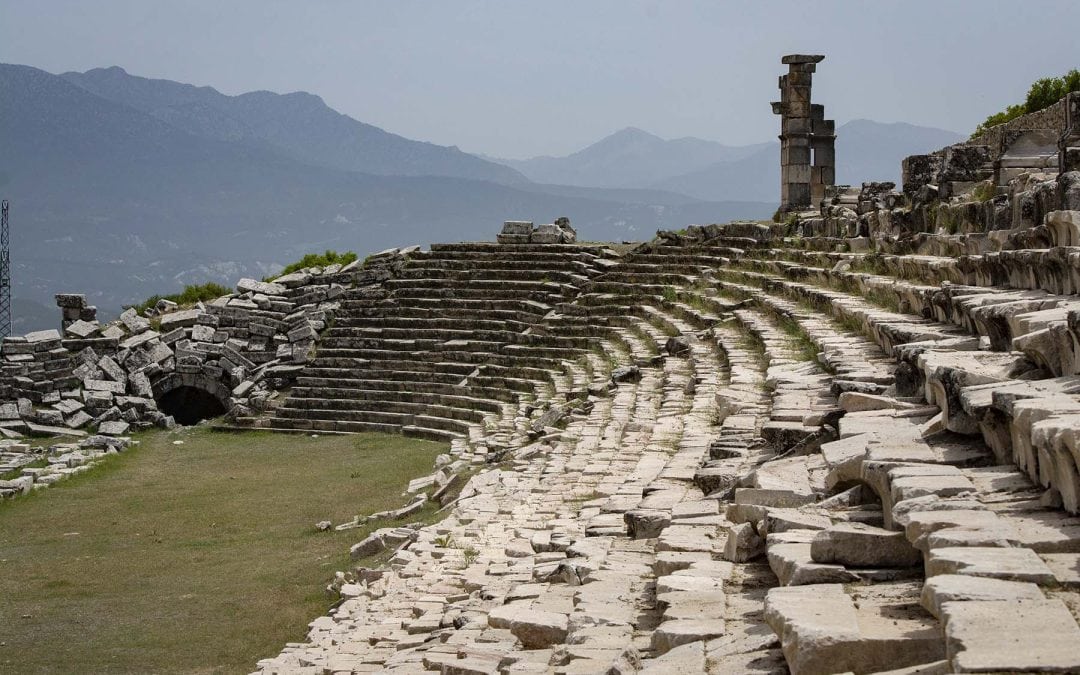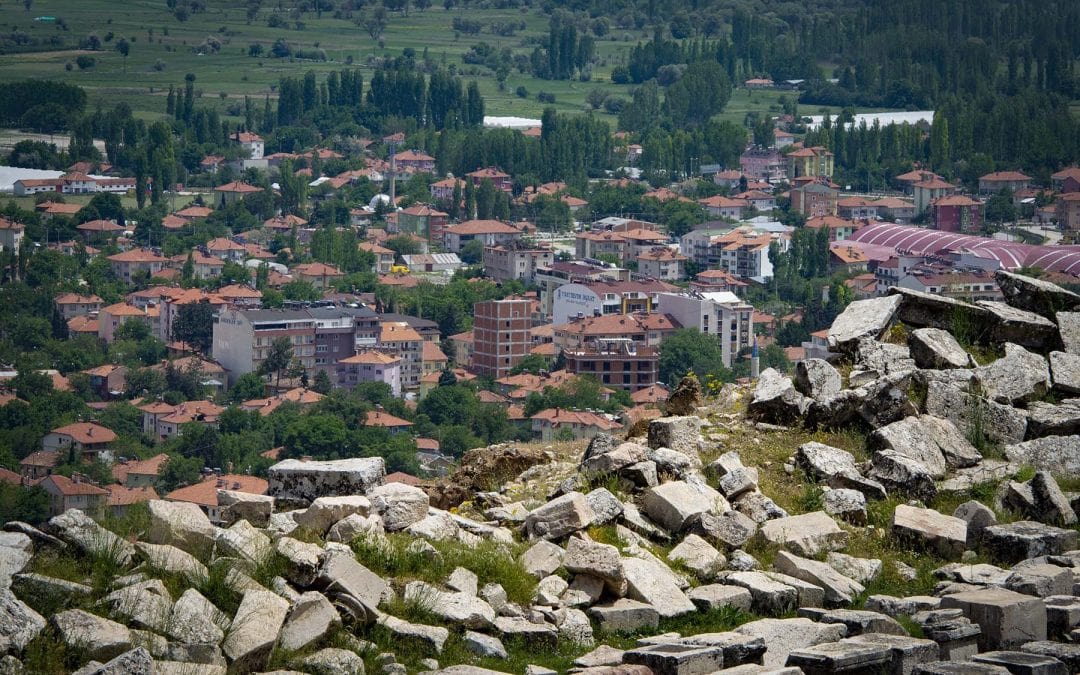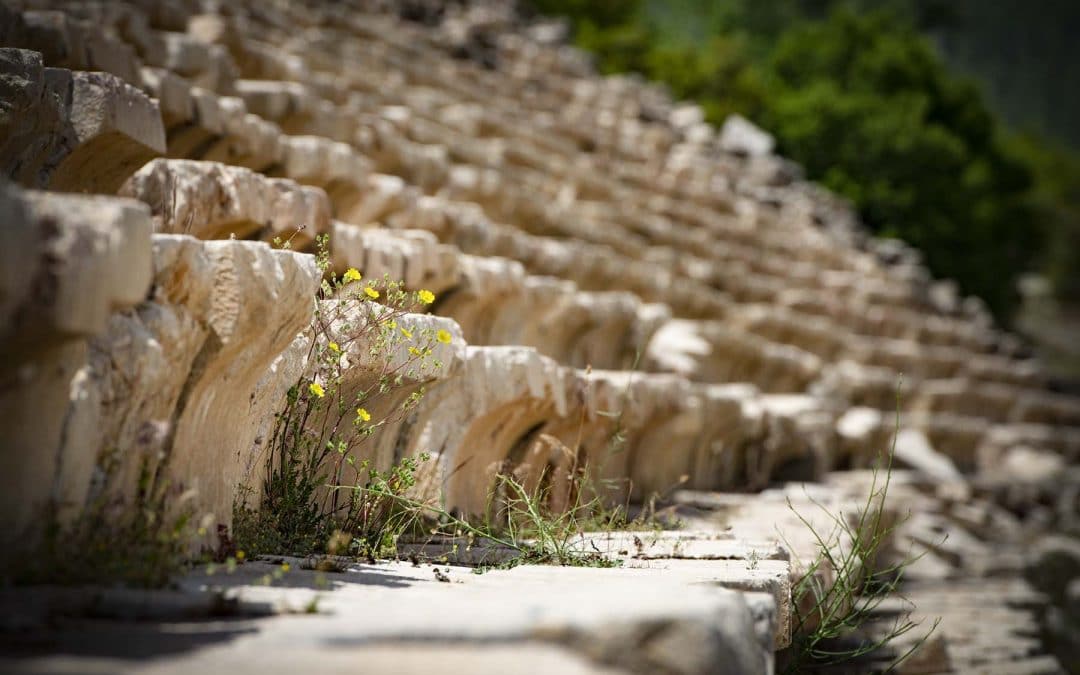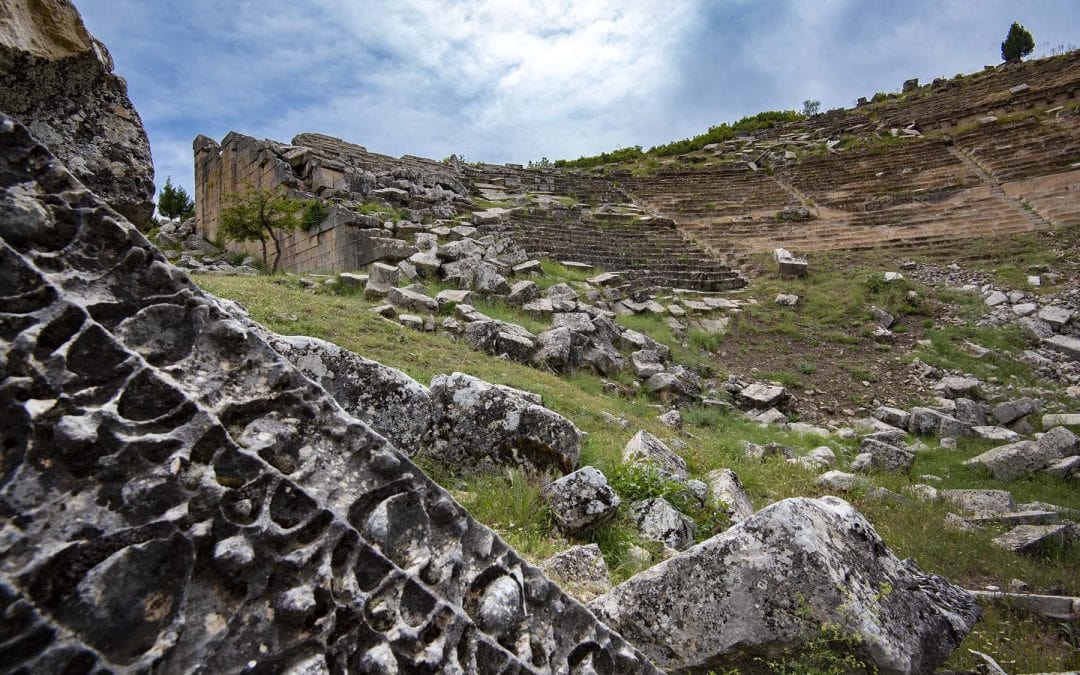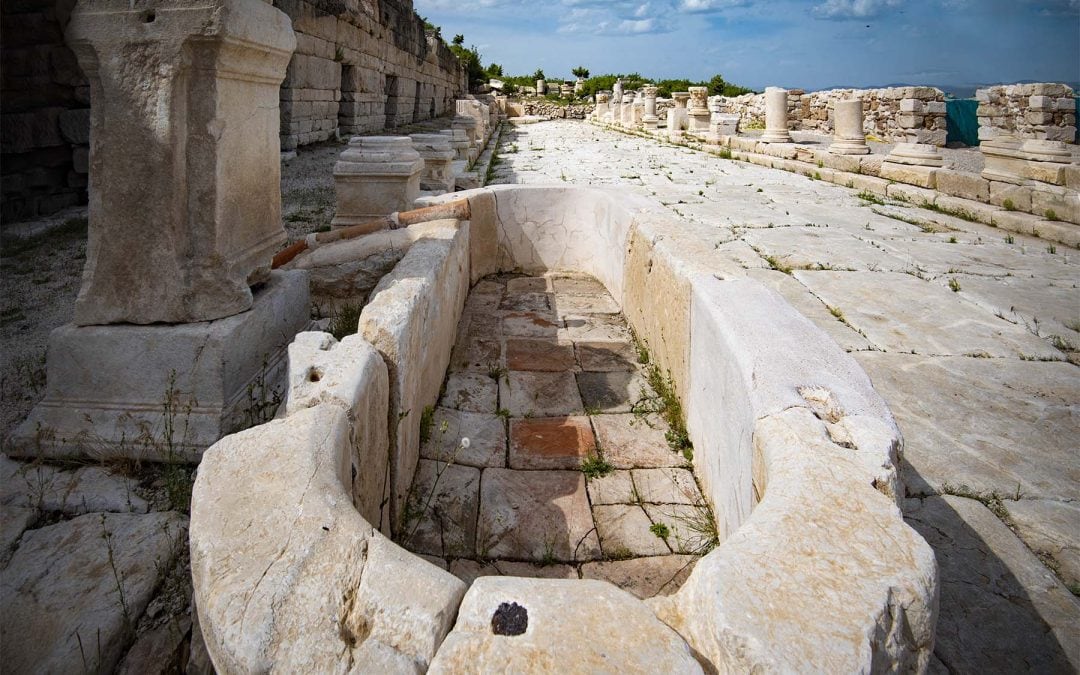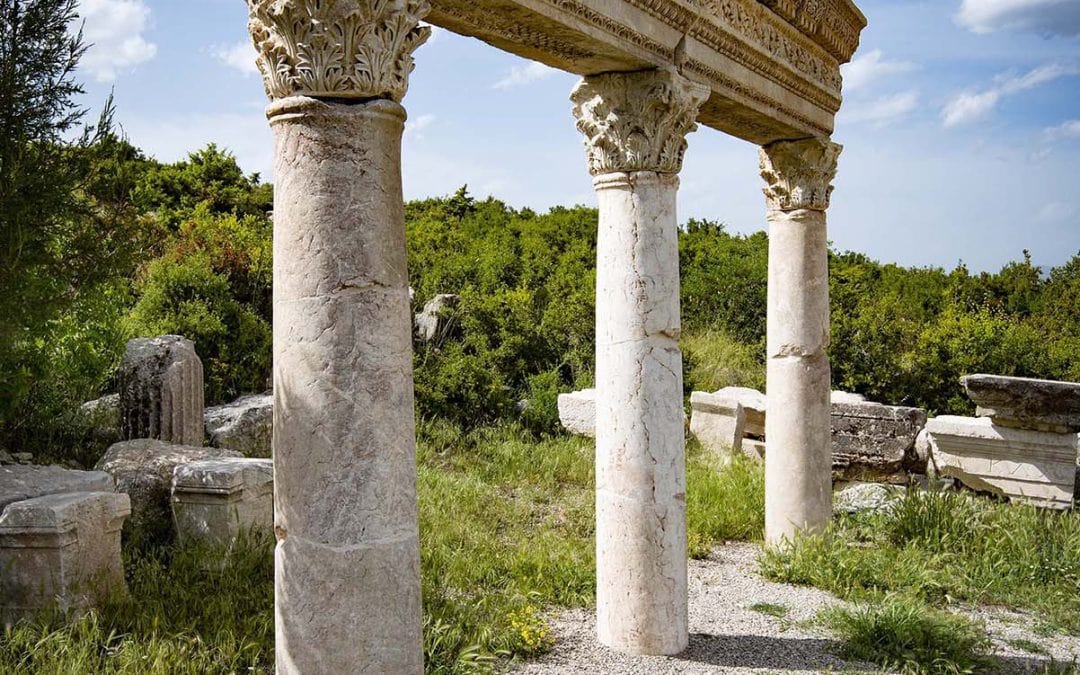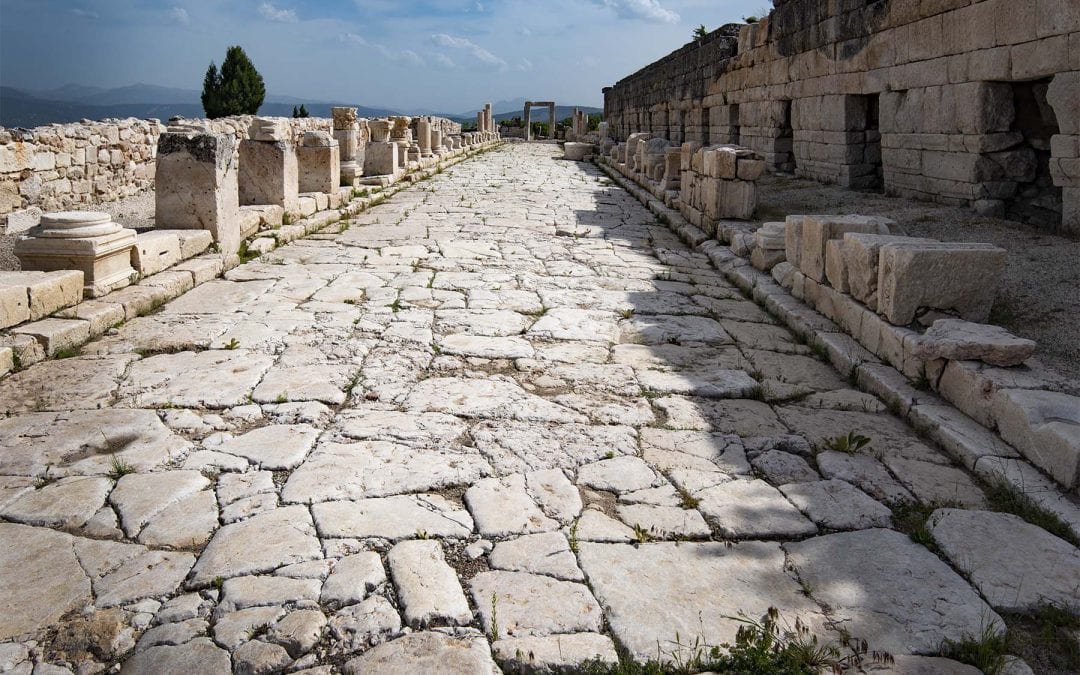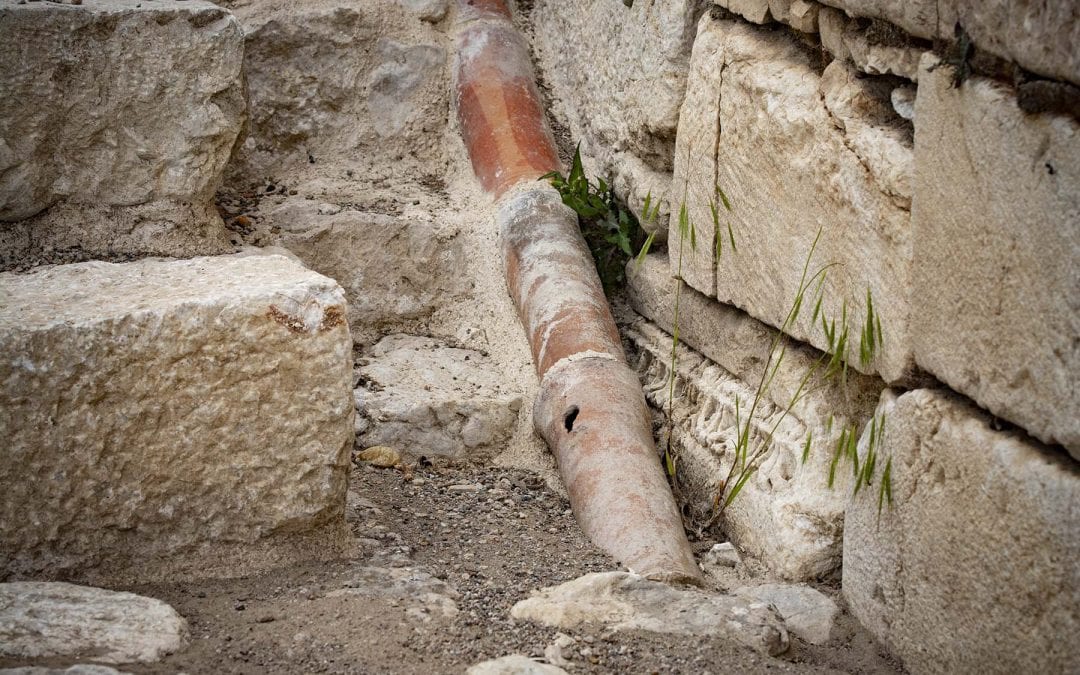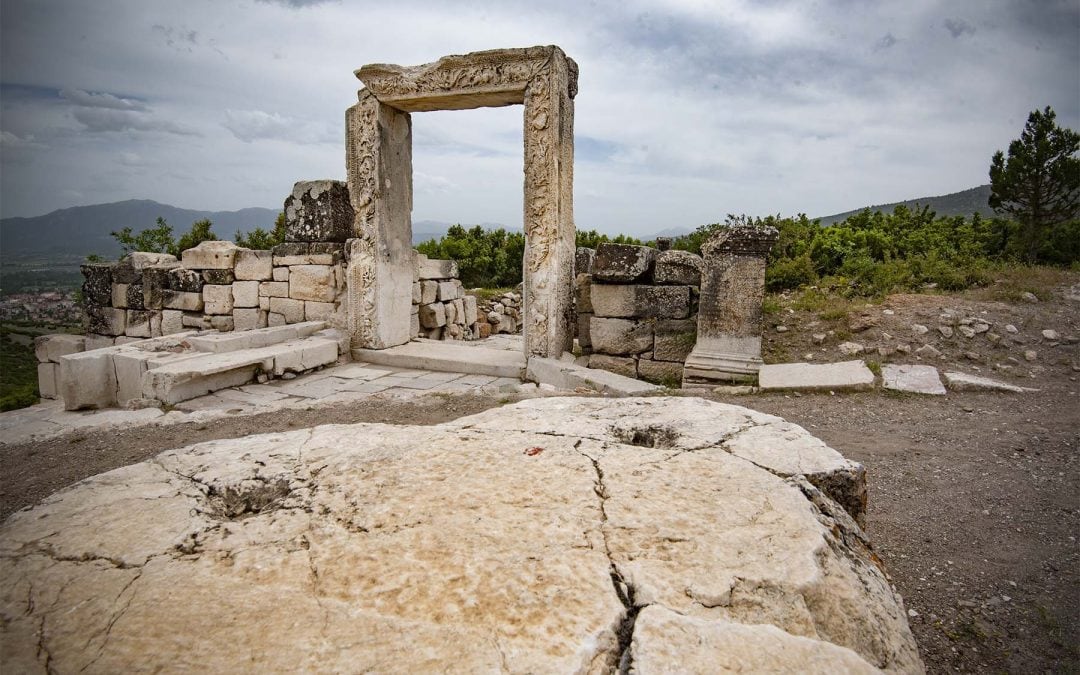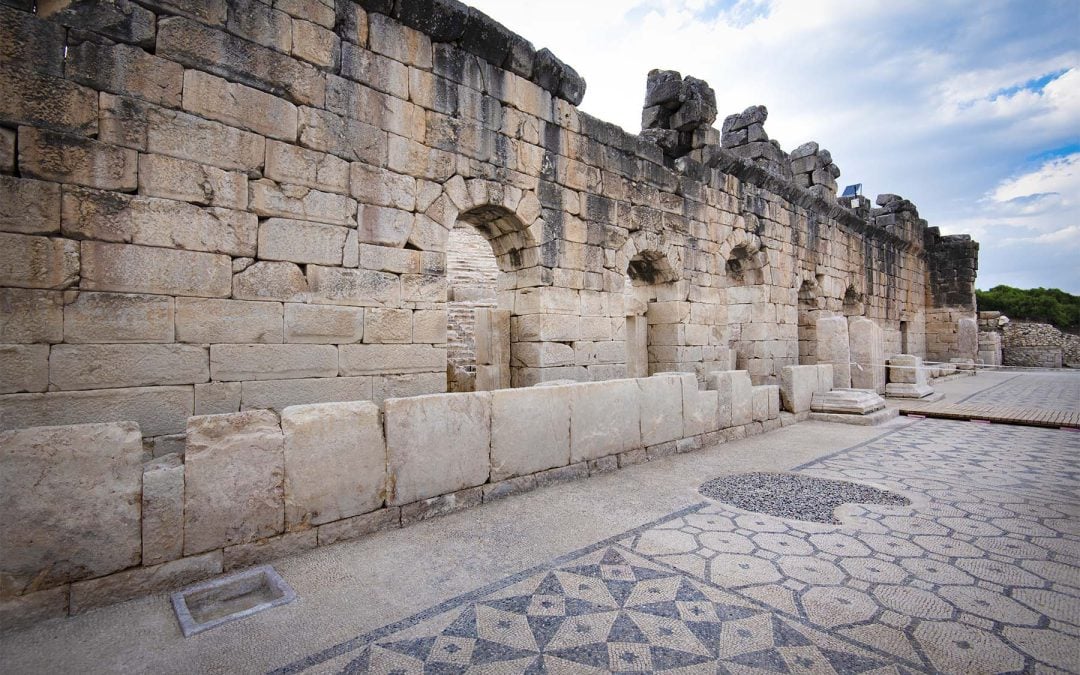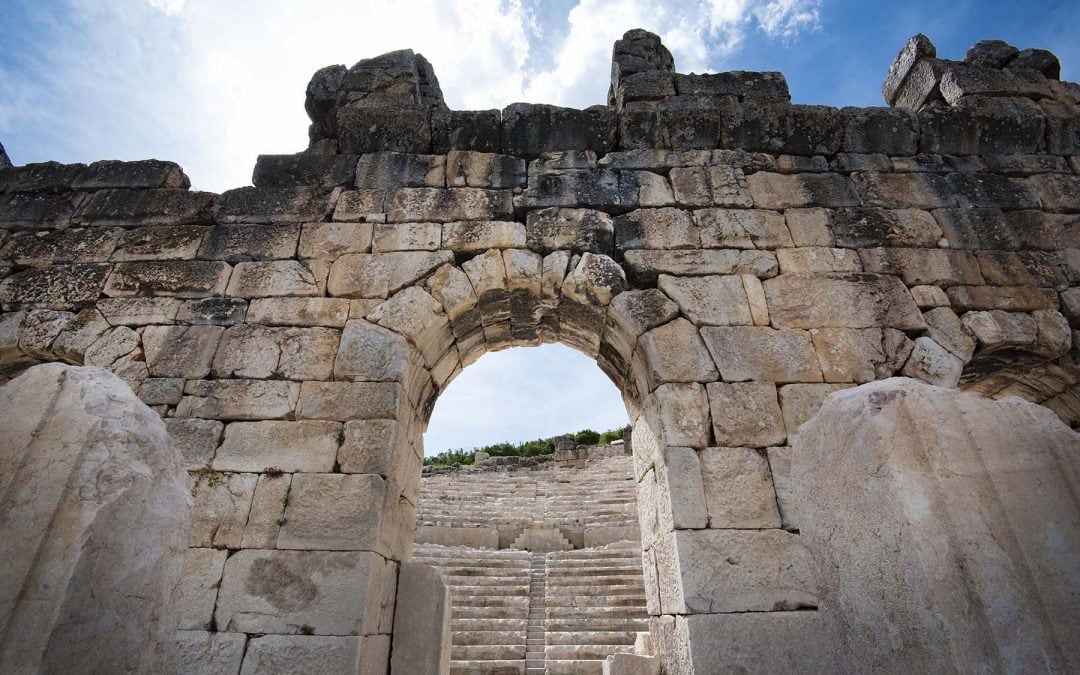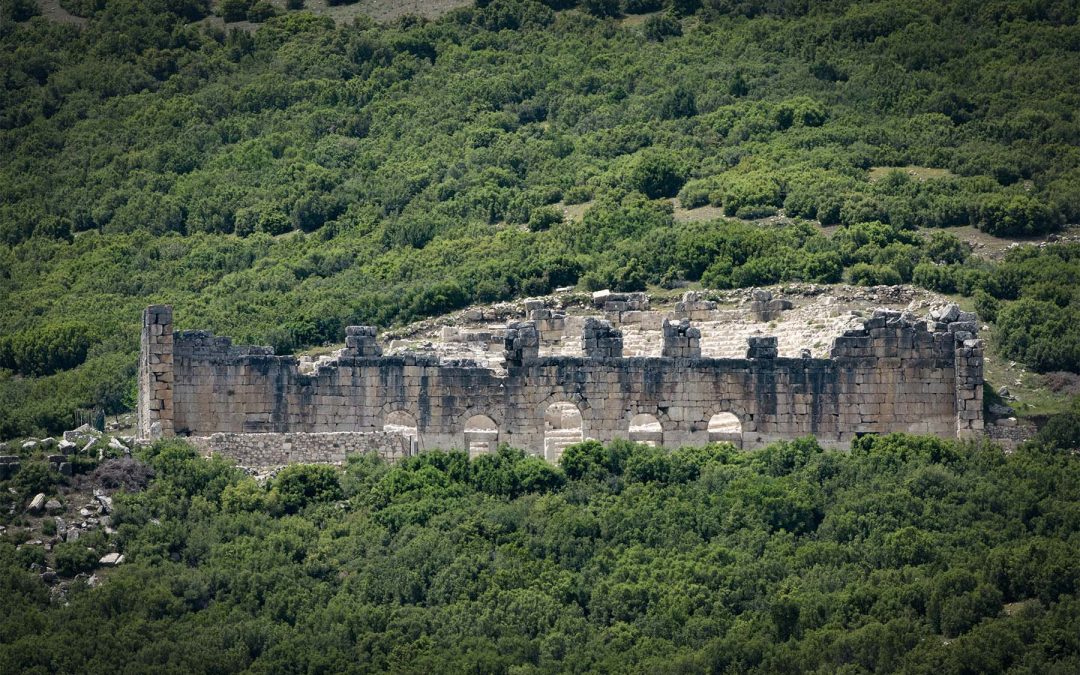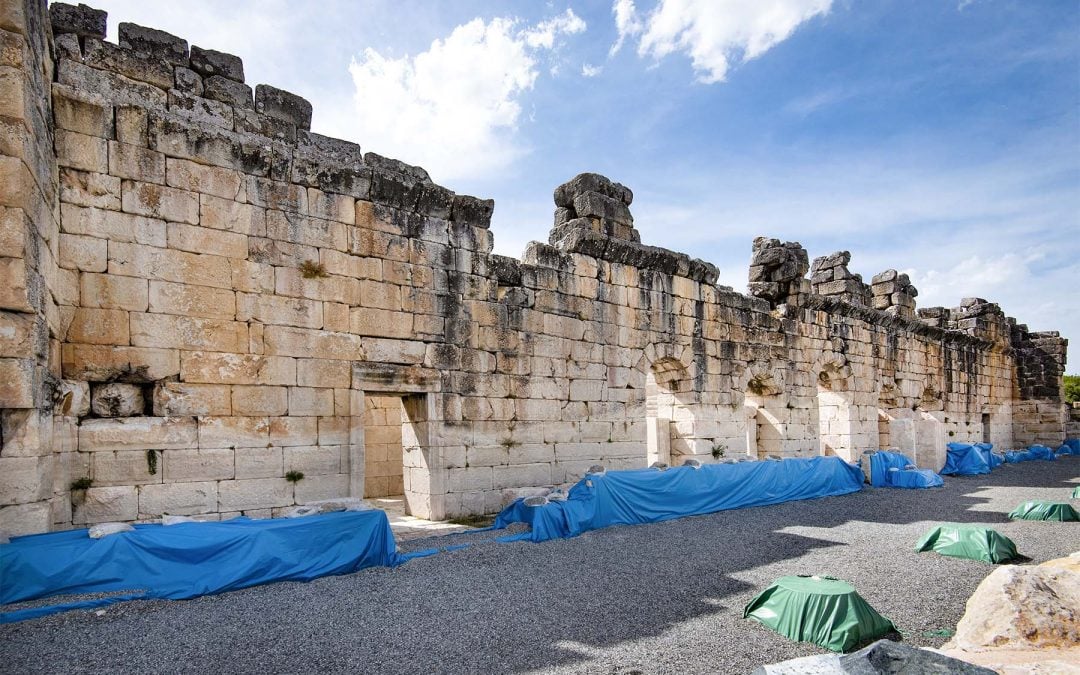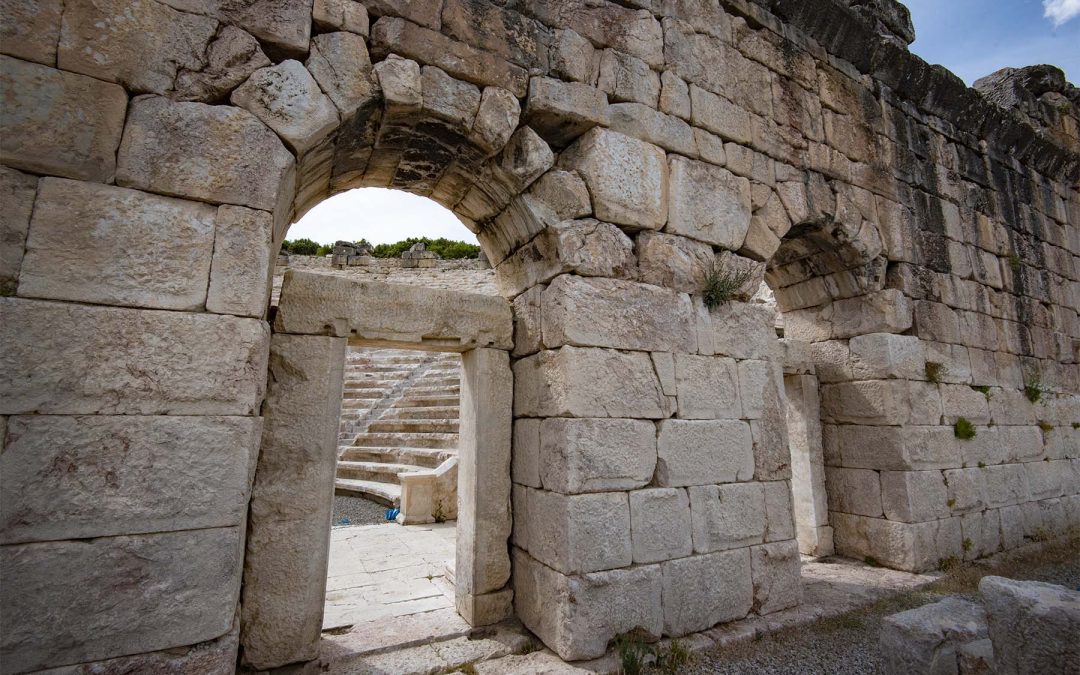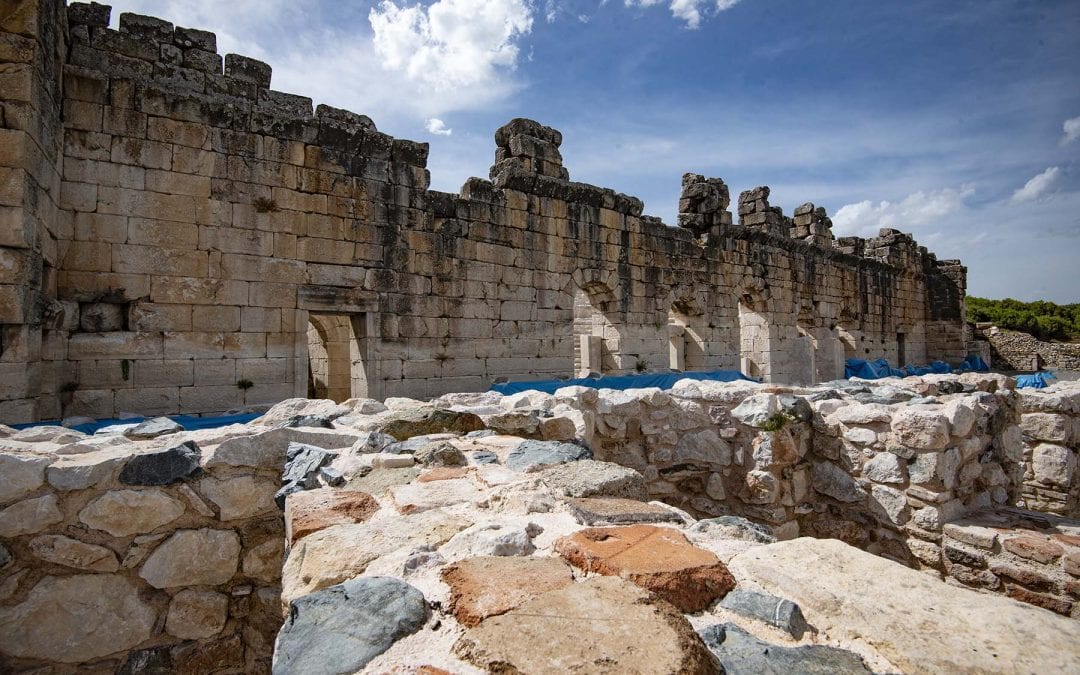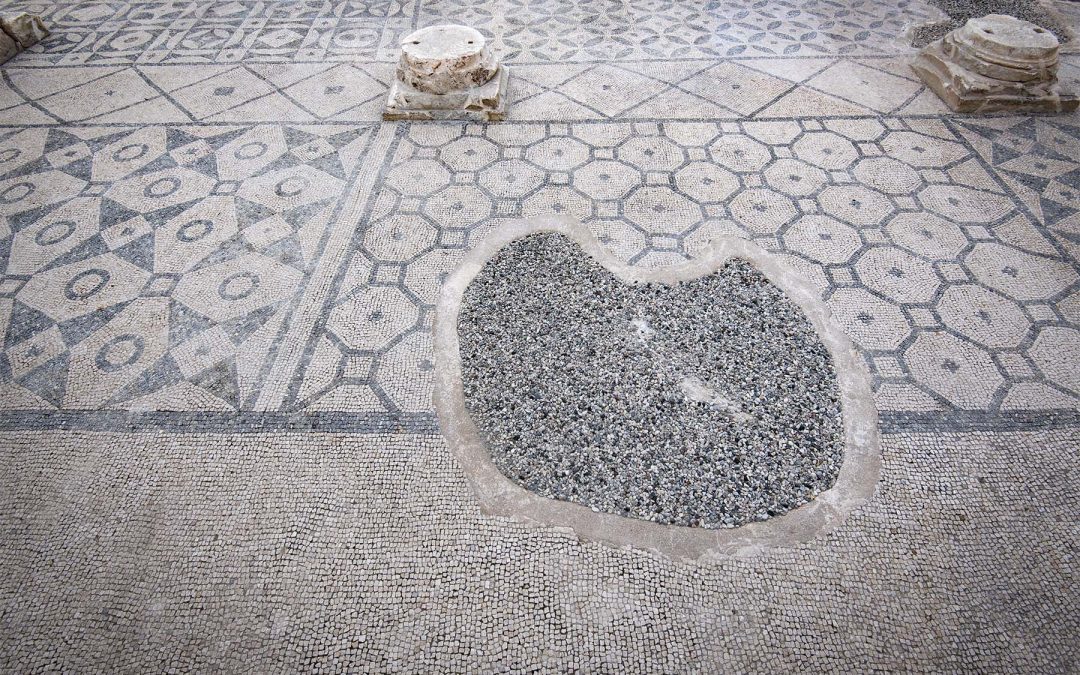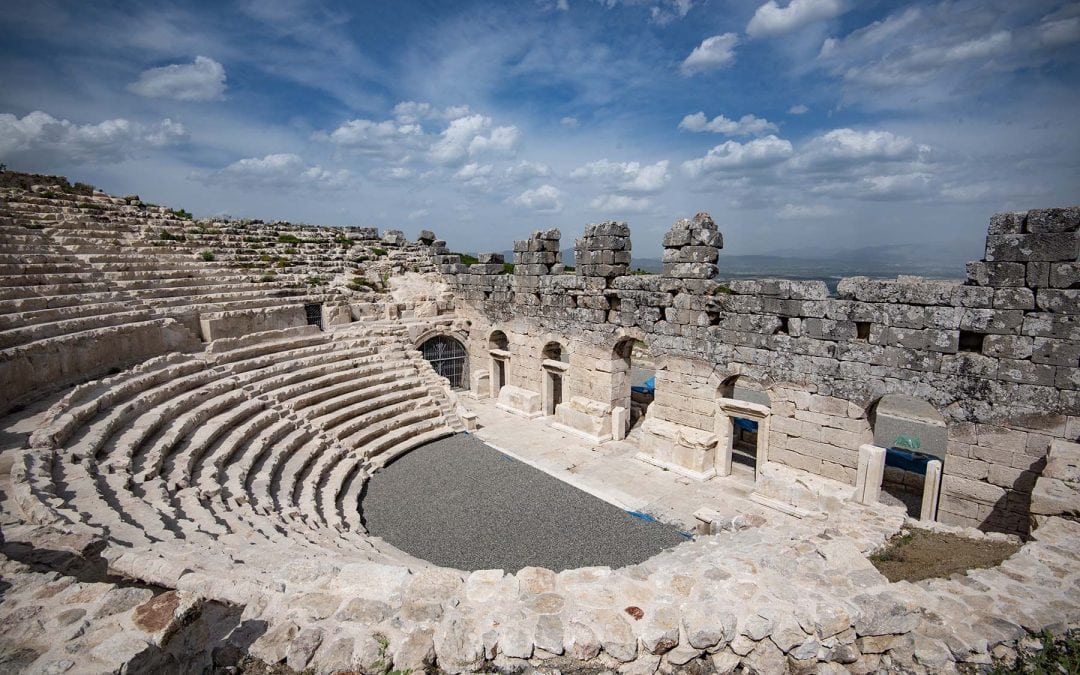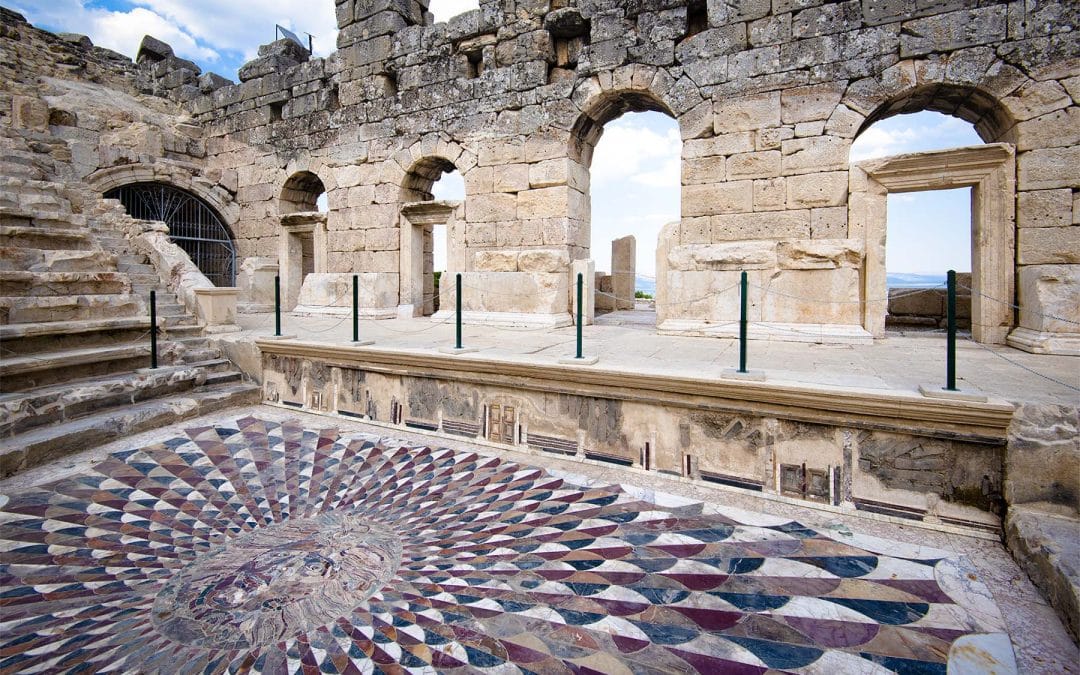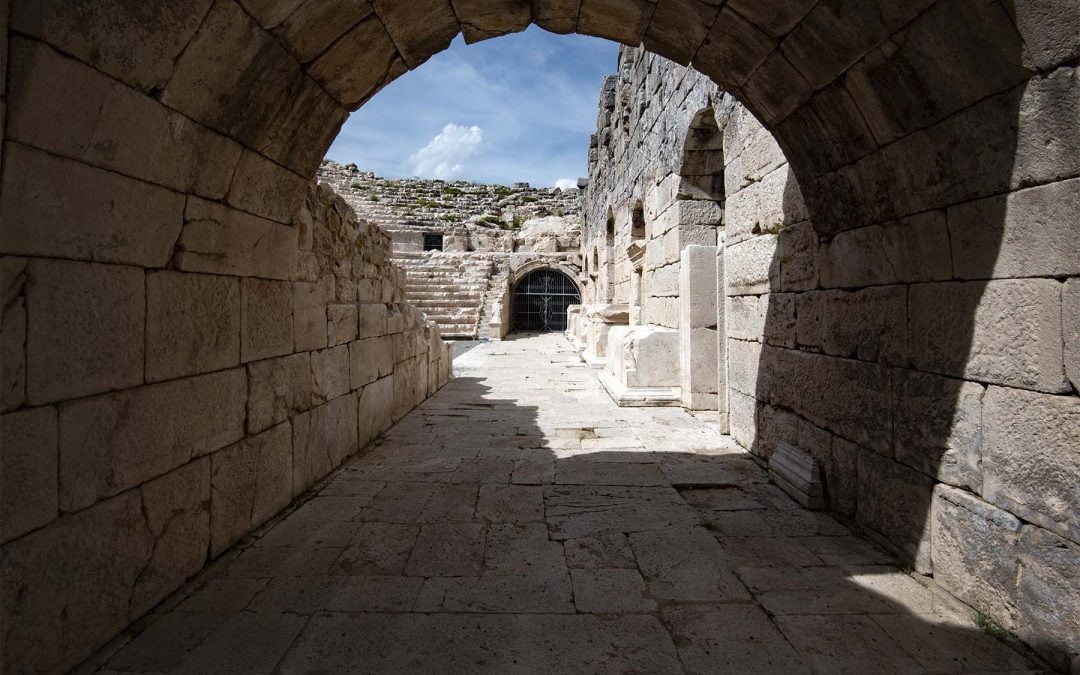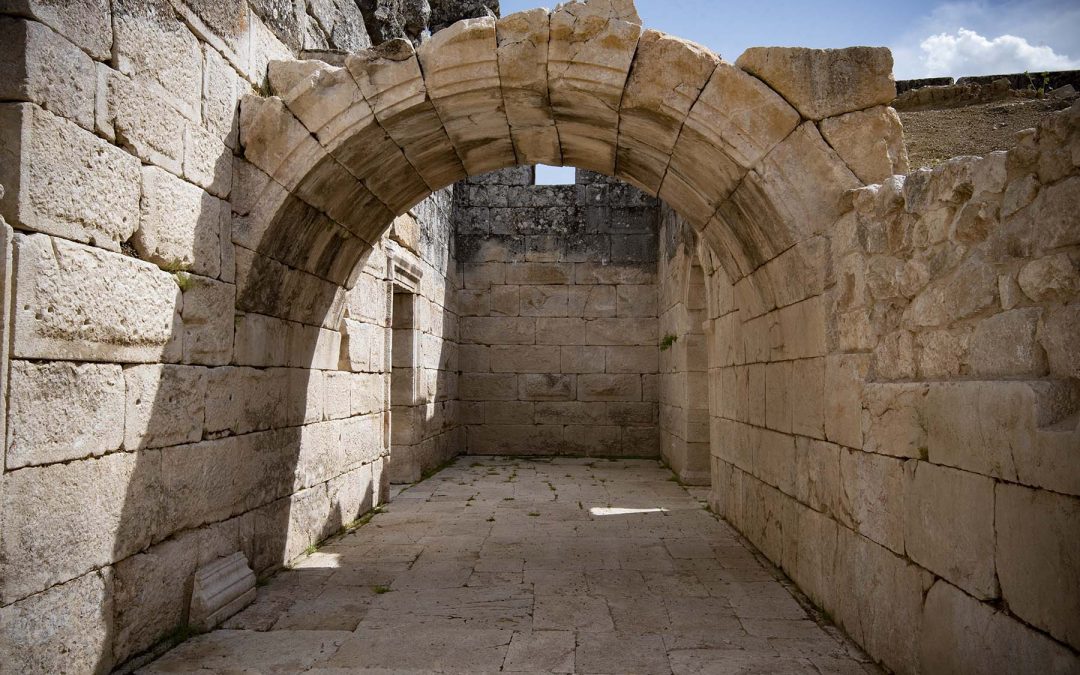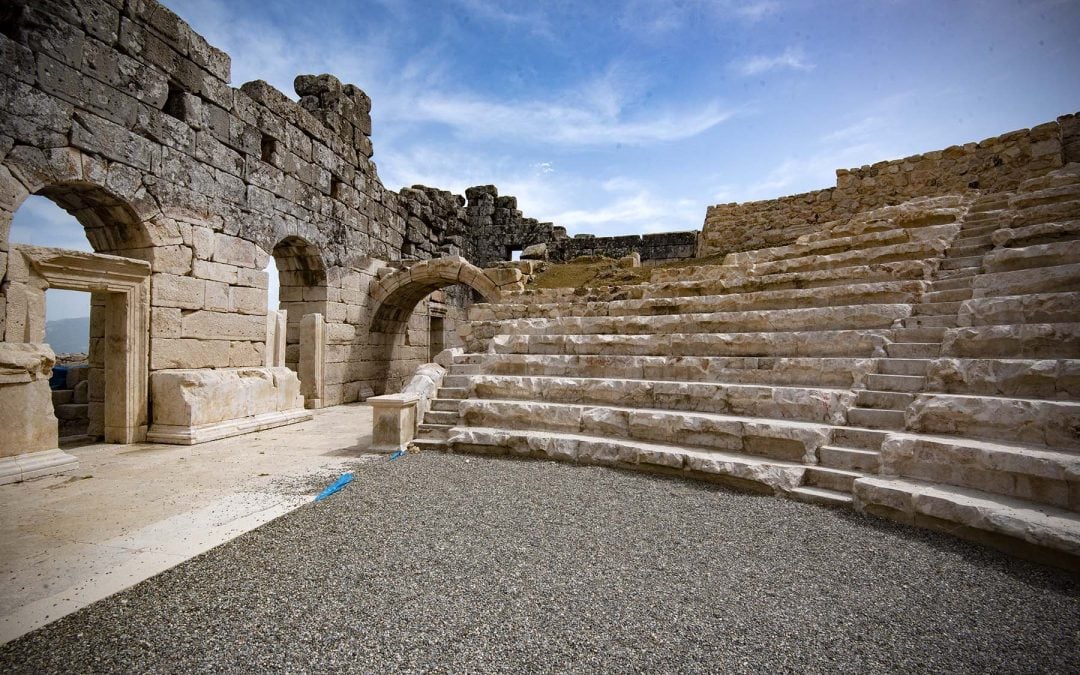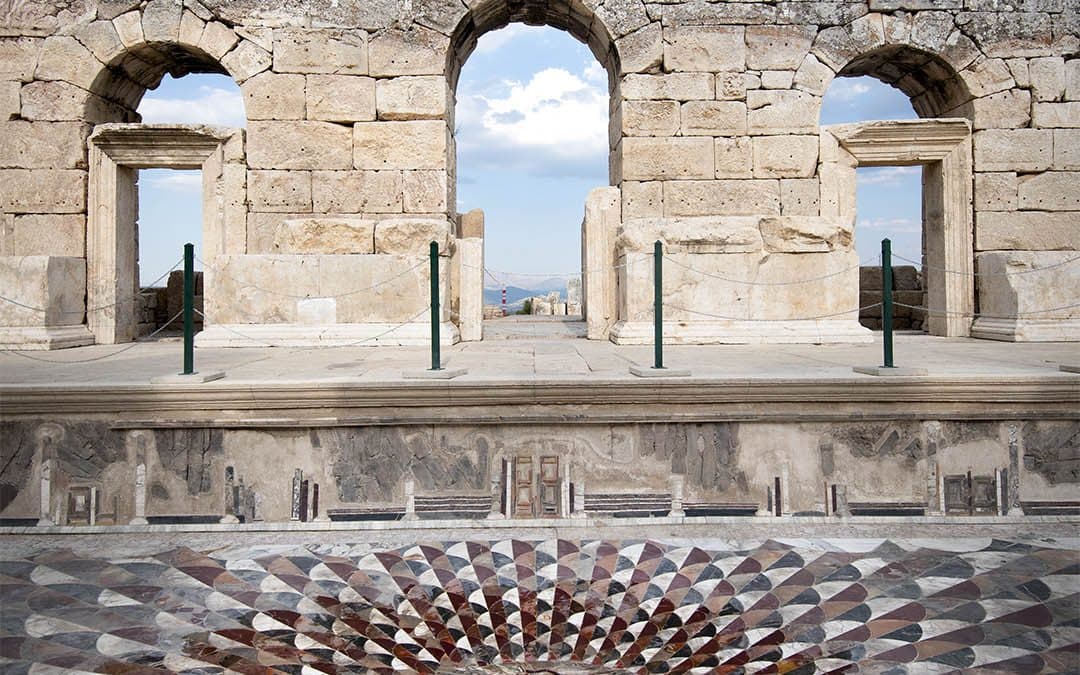Kibyra
Kibyra And The Medusa Mosaic
by Slowtravelguide
The ancient site of Kibyra is located roughly between the coastal town of Fethiye and Denizli near Gölhisar. It is a big site with impressive ruins.
It sits in reasonably natural surroundings, except for the city of Gölhisar being only a few kilometres away.
Theatre And Bouleuterıon On The Hillside
The Bathhouse (Hamam) Overlooking The Area
The Stadium
When driving up to the site and passing some sarcophagi near the road, the first significant building you encounter is the stadium—no sign of other buildings standing at the stadium because of the site’s sheer size.
The stadium itself will also knock you off your feet because of its size and location. This stadium giving place to almost 10000 spectators is 197 meters long and reflects the importance and power of Kibyra at that time.
History Of Kibyra
Being conquered by the Romans, Kibyra was before that known as Cibyra Magnum and was the principal city of Cibyratis. Kibyra was an essential city with much military force like infantry and horseriders.
The list of discovered ruins is quite long, a bouleuterion, a fountain, a large stadium, a necropolis, Roman baths, an agora, a theatre and the main street. The archeologic works started in 2006. You can’t keep wondering why it hardly gets any visits when you visit the site.
People likely decide to favour other more popular destinations because of the absence of other attractions or popular towns in the neighbourhood.
After seeing the stadium, you might think nothing else can beat this but be assured; the site has other surprises on its sleeve.
The Colonnaded Street
Kibyra is more than its Medusa. The main street, for instance, has some exciting features on its sleeve for you. Take a look at that water reservoir and the ceramic pipes of the water system.
What To Expect
How To Get There: Private, rental car (check the map below) or bus-line Fethiye Burdur goes past Gölhisar.
Nearest Airport: Antalya Airport.
Parking: Yes.
Terrain: Easy to medium.
Stroller: Yes.
Income: Free.
Facilities: In Gölhisar, 30min. walk.
Best Time To Visit: Between May and October.
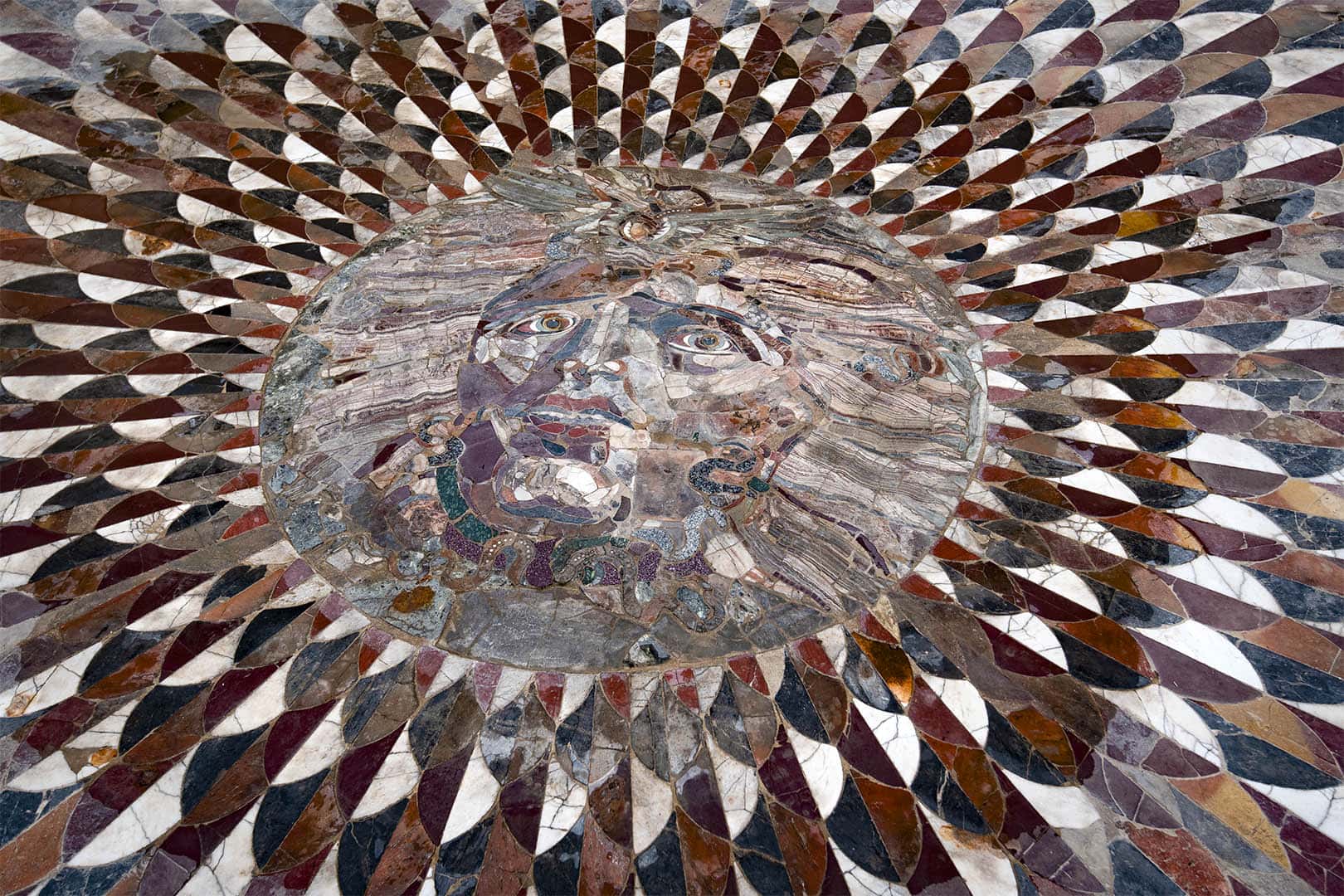
Several Columns In A Row At The Main Street Of Kibyra
Kibyra Theatre
To the north of the Bouleterion, the Theater, which has been well preserved. It dominates the entire landscape.
It is one of the medium-sized ancient theatres in Anatolia with a three-story seating row with a semi-circular plan, a five-door stage building and an audience capacity of about eight thousand people.
The seating areas are reached by two vaulted passages on the sides, the ornate door entirely intact.
Detail Of An Ornament At The Theatre
The Names On The Theatre Blocks
On the blocks of the walking path dividing the rows of seats horizontally, the names of prominent people of the city and their families are engraved as Hellence of their charitable works for the city.
In addition, the parts where the spectators were sitting were covered with a roof carried by wooden poles to protect against the sun and rain.
The Bathhouse (Hamam)
The Fountain At Kibyra
Mosaics In Front Of The Bouleuterion
The Mosaics At Bouleuterion
Suppose you visit the site out of the summer season. In that case, the jaw-dropping Medusa mosaic in the bouleuterion and the other mosaic floors around the building will be covered with pebbles to protect them from the elements.
So plan your trip with this info in mind if you want to see the stunning Medusa. We visited Kibyra with and without the mosaics protecting pebbles.
There are three inscription panels on the mosaic floor of Odeion:
Central Inscription
Year 226. When the asiarch Marcus Eprius Aurelius Orthagoras officiated (I), Aurelius Sopatrus, son of Epancrates, together with my brother Claudius Theodorus gave the promise of this mosaic.
Southern Inscription
To good fortune! Year 226. (I,) Aurelius Sopatrus, son of Epancrates, together with my brother Claudius Theodorus started to fulfil the promise of mosaic covering at my own expense for my supreme homeland, when Marcus Aurelius Eprius Orhagoras officiated, who, always memorable with the mosaic of the Olympian Odeion in front of the royal stoa.
Northern Inscription
Year 231. During the secretariat of respectable Lysimachus, Aur(elius) Sopatrus, son of Epancrates, together with his brother Theodorus covered with mosaic at their own expenses.
The Medusa Mosaic Floor In The Bouleuterion
The archaeologist discovered the Medusa mosaic in 2009. They were astonished by how well preserved 1800 years old mosaic was. The Medusa was 95% intact and made of thin slices of coloured marble plaques.
This technique is called ‘Opus Sectile’, making the Medusa mosaic a unique piece in the world. If you have any doubts about its beauty, this Medusa is really ‘stunning’. I couldn’t stop staring at it.
Kibyra Bouleuterion Is Impressive From Every Angle
The Bouleuterion
The Bouleuterion was used as a courthouse, theatre and as parliament. It has a capacity of about 3600 people, and it used to have a roof.
At first, after discovering the Medusa mosaic was covered by the archaeologists with five layers to protect it until inspection and restoration in 2013. It can be admired during the summer months.
The Colors Become More Intense When Wet
Look At This Detail!
Last View Of The Medusa
Practical Information
After parking your car at the stadium, there is a walk upon the (sometimes steep) hill to the rest of the site. In summer bring some water with you. Kibyra is a site that rewards its visitors with many beautiful ruins after the climb. Depending on the season you visit, you will be likely the only ones there.
Remember that you can not see the Medusa mosaic all year round, so plan your trip with this info. The Medusa is on display from May until Octaber.
Walking shoes, plenty of water and sun protection are essentials.
If you have any questions about a place feel free to ask. You can send us a message through our contact page or leave a comment on our Instagram or Facebook pages.
You can also join our group Turkey Travel Photography on Facebook to share your lovely photos or experiences about Turkey.
Places Nearby
Oenoanda, ancient site famous because of philosopher Dyojen (59km)
Lake Salda, Turkish Maldives (120km)
Keloğlan Cave, for those who are looking for coolness (26km)
Hacı Ömer Ağa Mosque (Yazır Village), hidden corners of Turkey (24km)
Places We Recommend
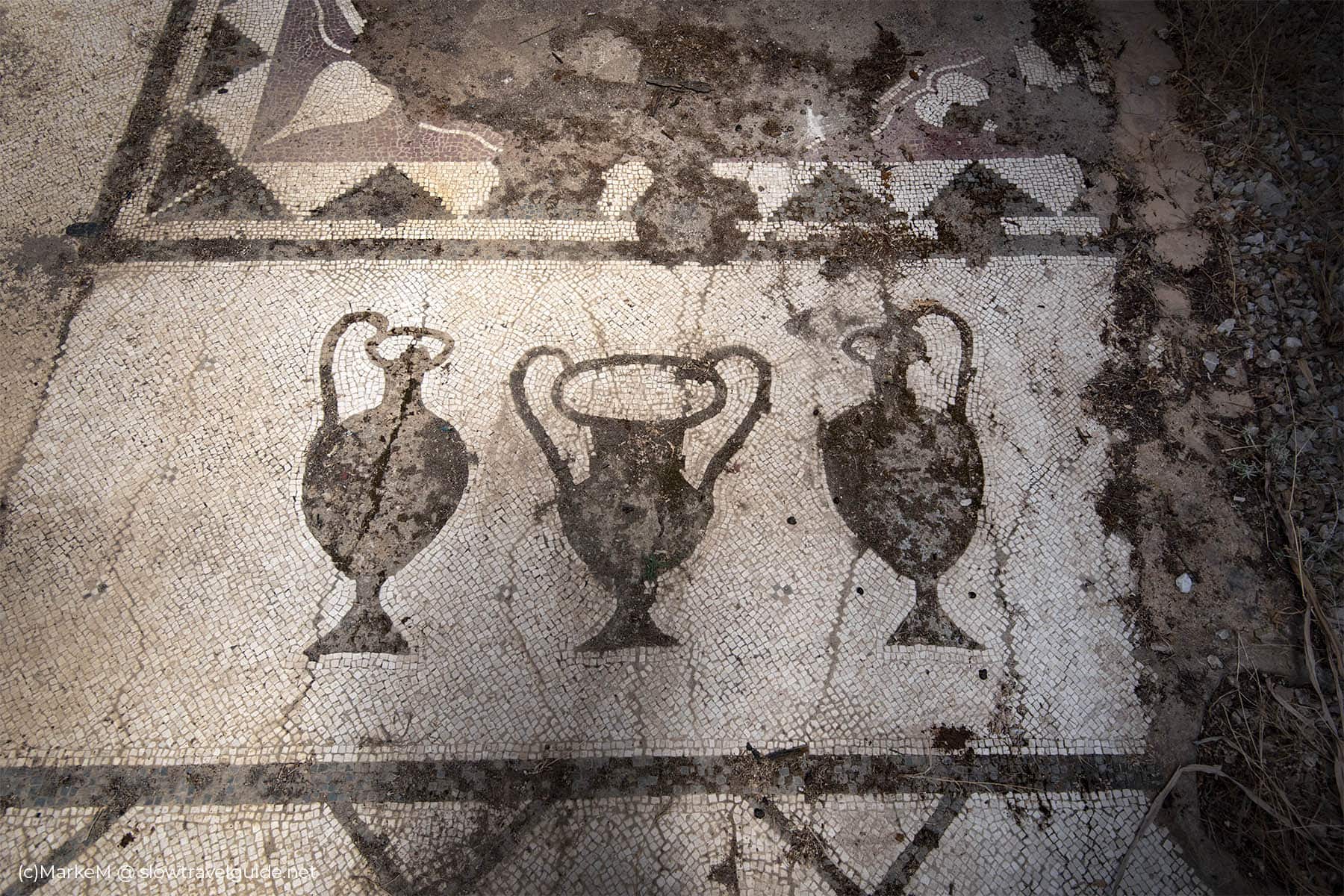
Iassos
On the southern slopes of the hill where the Castle is built, you can find the house of the mosaics. Stunning mosaics are under the display, and in the summer of 2021, the site started with building a new home for the mosaics. (Read more)
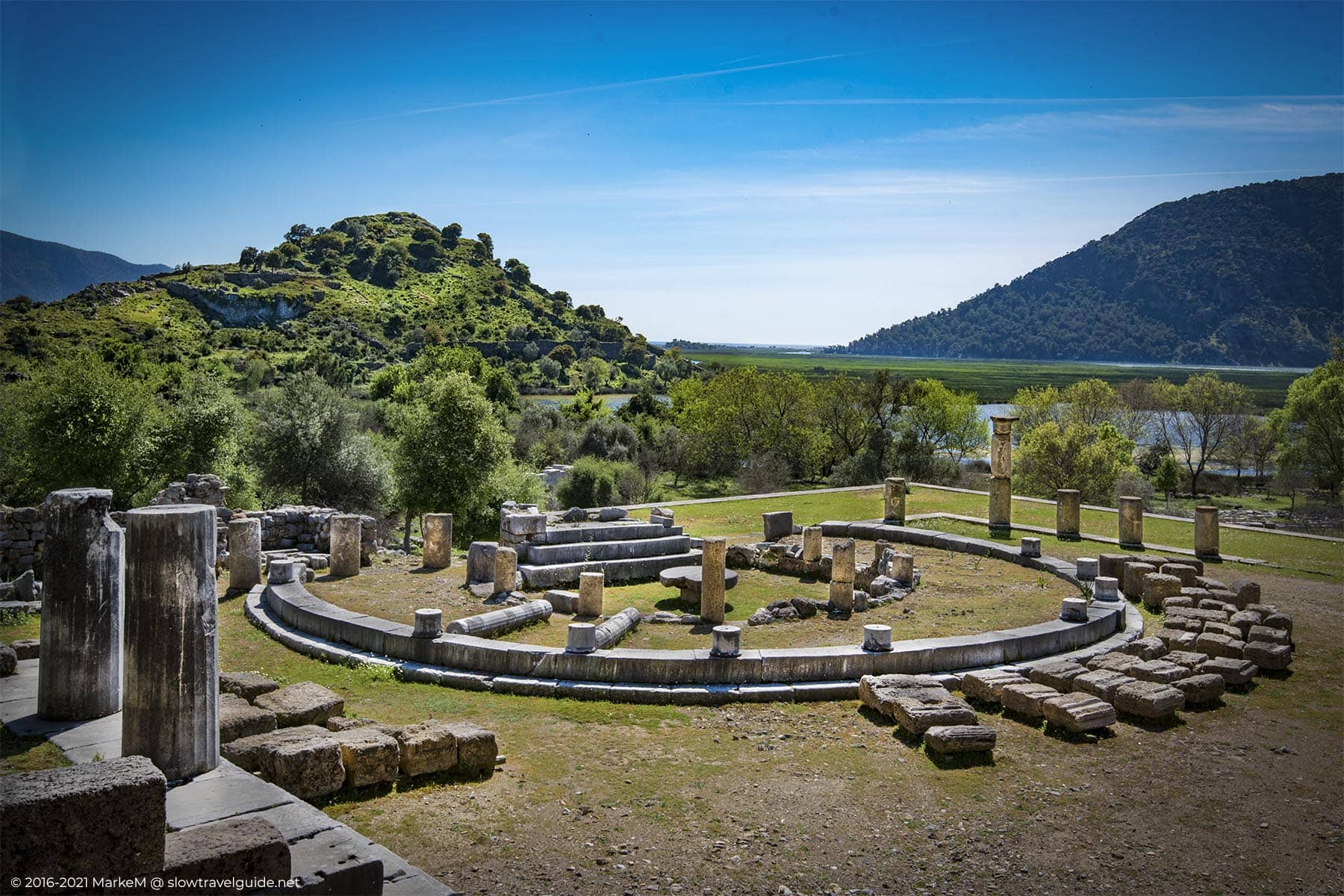
Kaunos
The ancient site Kaunos, near Dalyan, is known for its Lycian rock tombs, carved out the rocks overlooking the Dalyan river. (Read more)
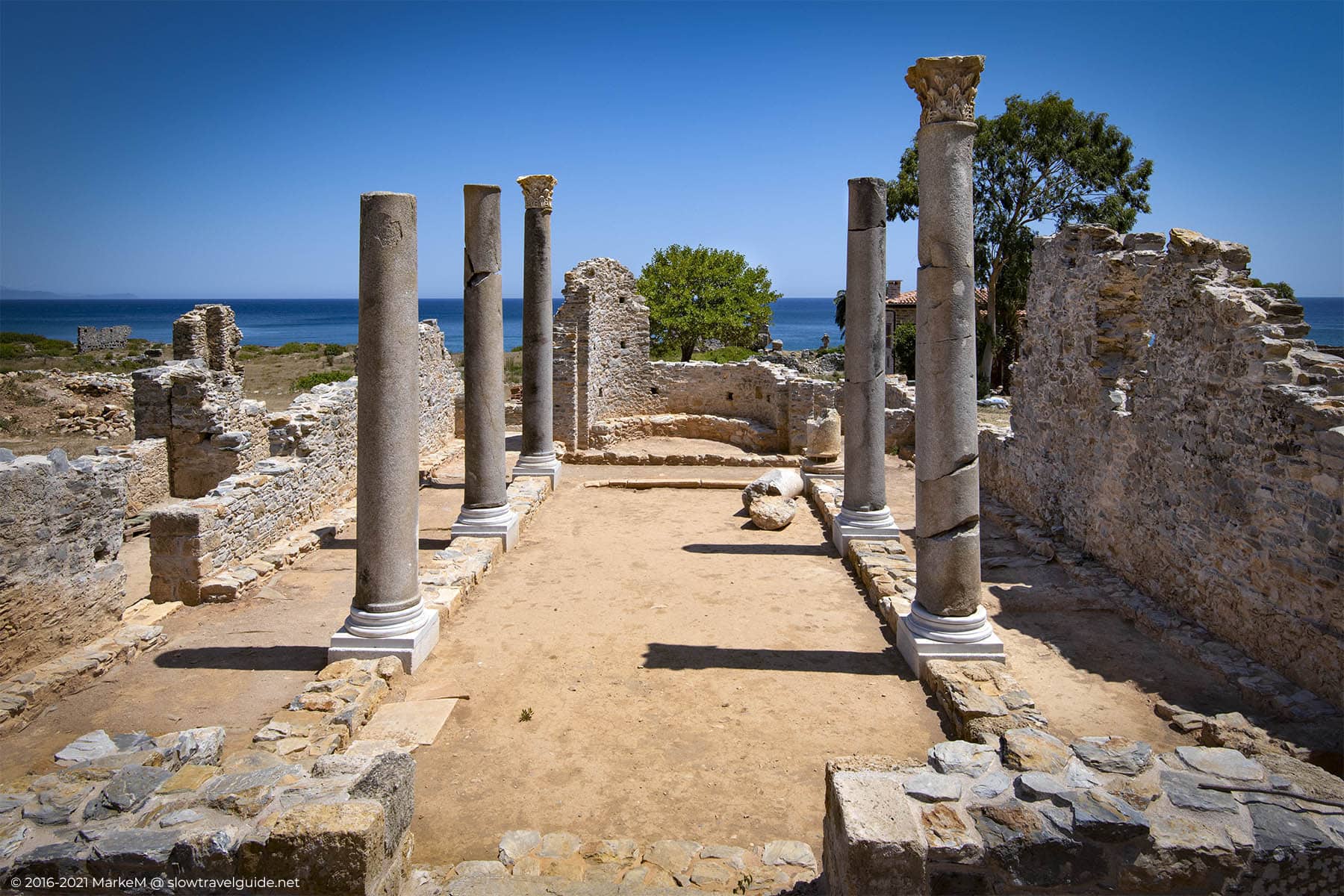
Anemurium
© 2016-2022 All rights reserved by slowtravelguide.net.
The content of this website is copyright protected and the property of slowtravelguide.net.No part of this website may be reproduced in whole or in part in any manner without the written permission of the copyright owner.
Copyright ©2016-2022 Tüm hakları saklıdır. Bu (slowtravelguide.net.) web sitesinin içeriği koruma altındadır ve slowtravelguide.net.Buradaki hiçbir içerik (yazı,fotoğraf,video vb.) izinsiz olarak kopyalanamaz, alıntı yapılamaz,başka yerde yayınlanamaz.

